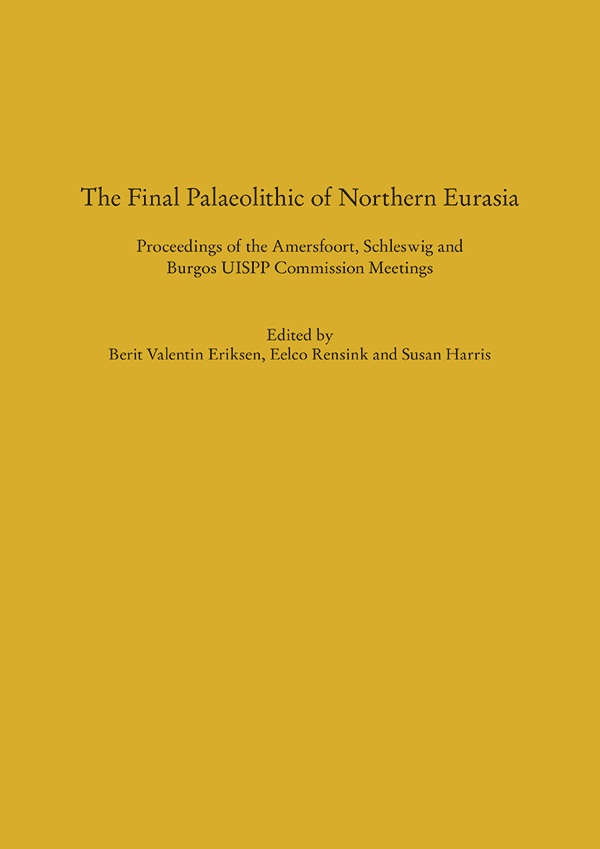The Final Palaeolithic of Northern Eurasia. Proceedings of the Amersfoort, Schleswig and Burgos UISPP Commission Meetings (Band 13)
Band 13 der »Schriften des Museums für Archäologie Schloss Gottorf«, Ergänzungsreihe

This volume brings together 21 papers presented at three different meetings of the Commission for “The Final Palaeolithic of Northern Eurasia” of the Union Internationale des Sciences Préhistoriques et Protohistoriques (UISPP). The meetings were held in the Netherlands (Amersfoort, 2012), Germany (Schleswig, 2013) and Spain (Burgos, 2014). The collection of papers reflects our ambition to stimulate and coordinate research on the Late and Final Palaeolithic throughout Northern Eurasia. From a chronological perspective, this time span saw the emergence and migration of hunter-gatherer groups into previously unoccupied territories across the North European Plain during the Late Glacial and Early Postglacial periods (approx. 15,000 to 8,000 BP). Given the magnitude of climate fluctuations and, as a consequence, changes in landscape, vegetation and fauna, the Late and Final Palaeolithic cultures of Northern Eurasia were characterized by a variety of adaptive responses reflected in their technologies, settlement patterns, subsistence practices, social organizations and even ideologies.
The present volume covers all of these topics on a broad geographical range. Thus, papers deal with Denmark (one paper), the Netherlands (three papers), France (one paper), Germany (six papers), Poland (four papers), the Czech Republic (one paper), Latvia (two papers) and Russia (two papers). Besides this geographical range, the papers address a diversity of material studies as well as site-oriented, region-oriented and national perspectives. In addition, one paper also presents a broad European perspective dealing with developments in human demography across Europe during the Late Upper Palaeolithic.
In view of the large geographic scale, the articles also quite predictably deal with many different cultural groups/traditions. As far as the western and central parts of the area are concerned, most papers focus on the Hamburgian Culture, Federmesser Gruppen and Ahrensburgian Culture, whereas the papers dealing with the archaeological record beyond the North European Plain sensu strictu are associated with e.g. a Belloisian site in France and Late and Final Palaeolithic sites in Russia.
The papers address various aspects of Late or Final Palaeolithic material culture and human behaviour in various palaeoenvironments. Yet, some topics are particularly highlighted. For instance, the re-investigation of finds from old excavations is featured in six papers (Hartz et al., Kotthaus, Berg-Hansen, Peeters & Rensink, Niekus et al., Veldhuizen & Verpoorte, Mevel & Grimm, and Neubeck). On the contrary, there is only one contribution featuring a new excavation of an open-air site (Riede et al.) and one paper focusing on intrasite spatial organization (Zagorska & Winiarska-Kabacińska). Three papers focus more explicitly on material studies (Moník & Eigner, Orłowska & Osipowicz, and Osipowicz, while two papers stress the absolute (radiocarbon) dating of specific inventories (Zagorska et al. and Baales et al.). Cultural traditions/relationships on a regional-scale is featured in five papers (Weber et al., Mevel & Grimm, Valde-Nowak et al., Sinitsyna and Zhilin), whereas only one article (Kretschmer) deals with a larger, European scale. One last paper (Sobkowiak-Tabaka et al.) focus on the palaeo-environment and human adaptation with respect to changes in the location of settlements and in subsistence strategies.
The articles demonstrate the high level of activity within this specific field of research, i.e. the Late and Final Palaeolithic of the North European Plain, over the last decade and it is particularly encouraging to see that many young scholars devote themselves to this period. The present volume addresses many questions posed by researchers working in different areas with approaches from different perspectives. We hope that the collection of papers will provide a solid foundation for future research on the Late and Final Palaeolithic.